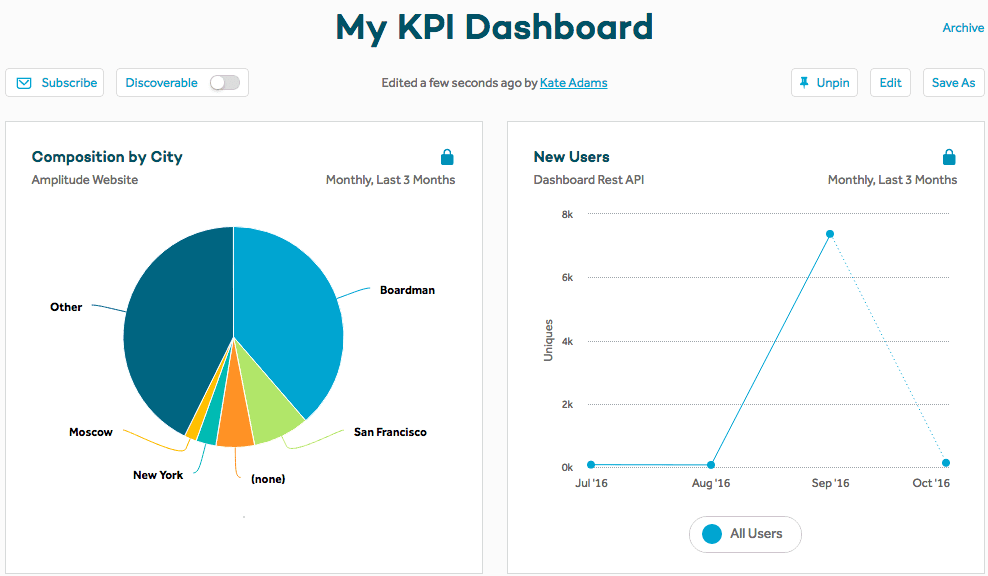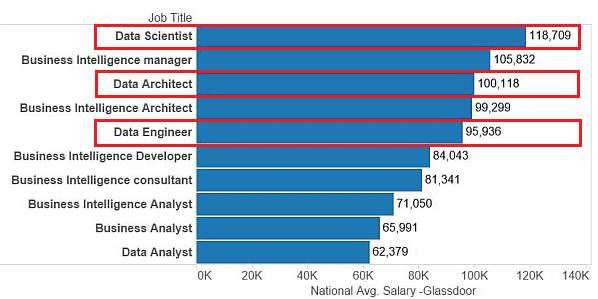The High Cost of Building Your Own Analytics
Buying an analytics platform is the answer because they've already thought of everything—there's no need to reinvent the wheel.
Anyone starting a business has done their fair share of research and analysis. You researched your chosen market, ran financial projections, and figured out startup costs. This proves you’re an analytical guru, right?
That’s why it’s tempting to think you can continue to rely on spreadsheets to manage on-going analysis. Although this isn’t the “wrong” approach initially, as businesses grow, it gets harder and harder and harder to manage your analytics needs. Your time becomes more valuable and can’t be wasted trawling through ever more complex spreadsheets.
You can build a system in-house, but the time and money this takes aren’t worth the effort. You’ve got a SaaS billing system because you don’t want to—and can’t—process payments yourself, correct? The same thinking applies to analytics.
Here’s why you should buy rather than build when it comes to analytics.
Spreadsheets will only get you so far
Building your own analytics platform will quickly spiral out of control. The need to know more about who your customers are and what they’re doing will lead you down the proverbial rabbit hole. You’ll have wasted time and won’t be any further along in building your core business.
Let’s see how this problem grows.
Customer tracking
It starts innocently. You launch your product and want to track new customers. Each new user gets their own row in your spreadsheet. You can track new customers month-over-month and come up with some easy to read graphs.
But what happens next? What do you do when you want to find out how these customers are really using your product, including:
- The specific features they use
- How often they use your product
- What they do right before they churn
So you need to start tracking customers through every single page of your site. You’ll need to create, manage, and insert some kind of tracking code on every single page to get this information. Then you have to link it to your magical spreadsheet.
Take this snippet code from Amplitude as an example. To track what your customers are doing once they access your website, you’d install something like this for each action or event:
amplitude.getInstance().logEvent('EVENT_NAME_HERE');
It’s not enough to know what actions are taking place, what makes your analytics more meaningful is know who is doing what. You can track this one of two ways:
- If your customers have to log into your site, you can track them by installing this code: amplitude.getInstance().setUserId(‘USER_ID_HERE’);
If sign in isn’t required to use your site, you can track anonymous users by installing this code:
amplitude.getInstance().setUserId(null); // not string 'null' amplitude.getInstance().regenerateDeviceId();
With manual tracking, you have to figure out each individual customer yourself and track each and every one of their actions yourself. As you’ve probably guessed, there are endless actions you can track, which means things can get pretty complicated.
Graphing data
With all the information you collect, you decide you need a central location to track stats and run reports. You need a dashboard. Welcome to a new level of complexity. You have to correctly build in all the places it needs to pull in data from. A mistake could cost you thousands of dollars in missed opportunities.
An example of Amplitude 2.0’s customizable dashboard [Source]

With a custom dashboard you have to graph customer composition manually, so that you know who your audience is. Skipping this crucial step means you won’t have a clue who you’re targeting and what makes them stay. With a pre-built dashboard, such as the one above, this is taken care of for you. You can quickly see which customers make up the majority of your users.
While we’re on the topic of mistakes, let’s not forget that mistakes can go unnoticed in spreadsheets and result in you making decisions that could cost you and your business lots of money. Spending hours combing through data is a waste of your time and there’s still no guarantee that all the issues will be found.
Performing analysis
So far, so descriptive. But what about actual analysis like finding out why customers are retaining or churning from your app?
You want to know what features cause some customers to leave while others stay. You’ll also need to figure out the correlation between each of these features and how customers respond. Not so straightforward.
Check out this correlation formula. Do you want to build this into your spreadsheet manually?
[Source]

OK, so you could use CORREL in Excel, but are you sure the numbers going into that formula are what’s needed?
Next you decide you want to run cross-platform analytics to see how your customers interact with your product across different platforms. This isn’t straightforward, so forget about using a spreadsheet for this. If you’re still set on building your own platform, be prepared to spend a huge chunk of time perfecting this.
Let’s not forget that you’ll have to build in security features. Available platforms manage this for you; it’s difficult to do on your own. How are you going to make sure the right people have access to data? Also, how are you going to make sure key pieces of data aren’t accidentally deleted? Spreadsheets are very limited when it comes to this, and building this from scratch will eat up hours of your time.
Are you starting to see the big picture? Building your a spreadsheet or a custom platform will drain your time and resources. An analysis tool will take all of this hassle off your plate.
Your money and time are valuable
This is the crux of the issue. Yes, you could do all of the above. If you’re a nerd, it might even be fun. But if you are building anything but an analytics platform, it is a monumental waste of time and money.
As your analysis needs get more enhanced, the costs to build your own platform will also increase. They’ll balloon beyond what you expect and cut into your profits. Why risk losing money you don’t need to spend when you can easily access tools that do the heavy lifting? Let’s take a look at the time and money you’ll have to invest to build your own analytics.
Time
Be prepared to spend months building your analytics from scratch. Not only do you need to build, your team will have to run A/B testing of the new platform, set up access controls, run regular maintenance and add to it as your needs change. Your entire knowledge of your customers rests on your analytics, so it has to be right.
In the time your team takes to build the new platform your response to customer concerns will slow down, so does your competitive innovation and revenue. If retention is a metric you want to track long-term, user experience is a huge part of this.
[Source]

You can’t afford to take time away from focusing on what your customers need. As the figure above shows, once you’ve attracted potential customers based on strategic alignment with their needs, to convert them to actual customers you have to increase your level of engagement. You do this by building a strong relationship through ongoing dialogue. You’ll see a shift in retention because as you make the most of their experience and give them what they need, they become your advocates.
Money
Let’s get down to the actual cost in cold, hard cash.
Let’s say you’ve got a single developer working on this for 50% of their time. This means that if you are paying the developer a salary of $150,000, developing analytics is costing you at least $75,000 per year. Analytics you can’t even use until they are finished.
Compare this with the cost of actual analytics you can use today.
This is at the low end of the spectrum. It won’t be a lone developer working on this half their time. To do it well, your data team will also have to get extensively involved. Instead of using your analytics to, you know, analyze, they will be working out how to structure data and how to build an analytics platform.
You’ll have to hire a team of experienced data scientists, engineers, and developers. Here’s how much they’ll cost you in salary:
[Source]

Before you’ve even started to build anything, you’ve potentially committed yourself to paying over $300,000 a year to have a team in place. Each month that’s costing you approximately $25,000. The decision to hire a team dedicated to maintaining your analytics will cost you $23,000 MORE per month.
This is not to say that you won’t need data scientists on board even if you buy an analysis tool. The truth is you will, but you’ll need fewer of them and their time will be spent more productively.
The cost to your customer
The costs don’t stop there. These are only the upfront costs to your company in terms of hiring and time committed by your team. But having their attention focused on building internal tools means they are not concentrating on the core of your business—your external product.
This costs customers. Which costs you.
Let’s take a look at how your revenues are affected. If your team is customer focused, you can have low churn and high growth.
If your team is focused on building internal tools like analytics, the opposite is true: high churn and low growth. This is for exactly the reasons outlined above. Your team can’t take the time to deal with customer requests and focus on customer success. This leads to churn. This in turn hurts your growth as your product becomes known for bad support and low customer success scores.

Let’s say a customer-focused team has a churn rate of 10% and an MoM growth rate of 10%. Over the course of a year, an initial $10,000 in revenue would grow to almost $150,000 MRR.
But an internally-focused team could have a higher churn rate of 15% and a lower growth rate of 7%. This leads to throttled growth and only $95,000 in MRR by the end of the year. In this scenario, choosing to focus your team’s efforts to building an un-needed tool has cost you $55,000 in monthly revenue, and growing.
If you’re focused on building your own analytics, you’re wasting your time and money. Unless you’re in the business of analytics, you can’t afford this. While your team is focused on building a new platform, they’re not focused on helping you grow your core business or your bottom line.
Put together, the internal costs of your team and the external costs that hit your revenue, add up to hundreds of thousands of dollars.
Understand the benefits of not going at it alone
Take the guesswork and risk out of building your analytics and accept that there are some things you just shouldn’t do yourself. Find an analytics tool that does what you need so you avoid frustration and can stick to doing what you do best.
Long-term cost savings are an obvious bonus for buying, but there are other benefits to buying an analytics platform. For example:
- You have access to real-time analytics: If you want to see how many customers bought a specific package at a specific point in time, you can quickly access the data and be responsive to customer needs.
- You reduce the risk of incorrect calculations: Building your own analytics means hours spent testing all its features and formulas. With an analytics platform you can be confident that the data you have is correct. Your business has a much better chance of going the distance if you know who your customers are and exactly what they’re doing.
- You avoid manual work: Adding data manually to spreadsheets or a custom platform leaves room for human error. Analysis tools are usually fully automated and practically take away the risk of adding in the wrong number, leaving out crucial data or duplicating data.
- You enjoy data accessibility: Anyone can access data when they need it and make decisions quickly. They don’t have to wait for a spreadsheet and try to figure out how your custom platform works.
- Data is presented in a user-friendly format: No need to stare at countless spreadsheets without understanding what you’re looking at. You don’t have to be a data analyst to figure out what steps you need to take to give your customers what they need from you.
So what’s the solution?
Stick to your strengths and delegate tasks that others can do better. Buying an analytics platform is the answer because they’ve already thought of everything—there’s no need to reinvent the wheel.
Let’s say you forget to build a way to measure how customers move through certain steps. With a custom build, you’d have to take more time to build and test this. Meanwhile, analytics platforms have already thought of this for you.
Don’t let the cost of these platforms stop you from moving forward. Many are free and meet your basic analysis needs. For the ones that feel costly, look past this and consider the potential for long-term gain. You’ve wasted less time, have a trusted partnership with a company that specializes in analytics, and you have time to focus on your core business. By doing it alone, you’re taking away from your productivity and bottom line.

Alicia Shiu
Former Growth Product Manager, Amplitude
Alicia is a former Growth Product Manager at Amplitude, where she worked on projects and experiments spanning top of funnel, website optimization, and the new user experience. Prior to Amplitude, she worked on biomedical & neuroscience research (running very different experiments) at Stanford.
More from Alicia




